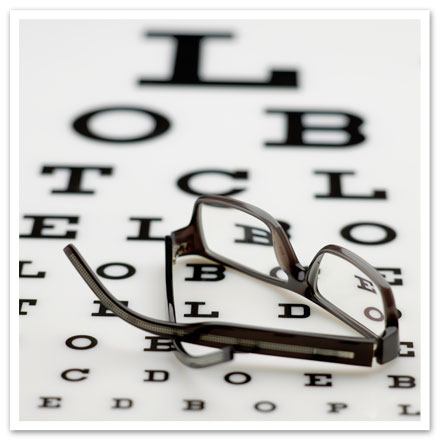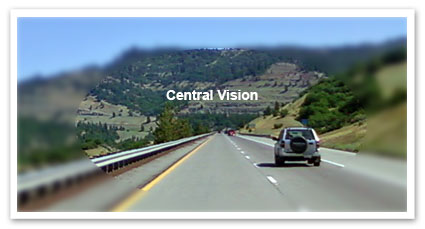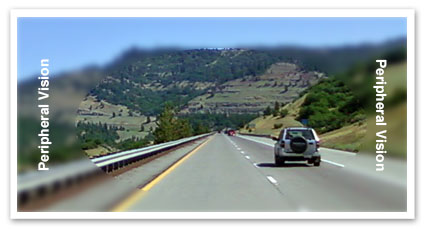August is National Eye Exam month! It’s incredibly important to get regular eye exams, especially for drivers. You may think your vision hasn’t changed in recent years, but sometimes we don’t even notice a change in our vision. Keep reading to find out more about the eye exams required for driver licensing and vision requirements for drivers by state.
Eye Exams and Driver Licensing
Your vision is extremely important to the driving task. Therefore, before you get your license, your vision will be tested at the license office. If you normally wear glasses or contacts, make sure you’re wearing them when you take the vision screening and let the license branch personnel know.
If your vision doesn’t meet state standards, you’ll have to visit an eye doctor for an examination. You’ll typically need a written statement from your doctor stating that your vision has been corrected to meet state standards before you can take the vision screening again and continue with the licensing process.

Field of Vision
Your field of vision is the area you can see while looking straight ahead. This includes your central vision, which is your clear, direct sight, and peripheral vision, which allows you to see out of the corners of your eyes.
Central Vision is your clearer, more direct sight, and it corresponds closely with your line of sight. It extends from the center of your vision out, in a 10-degree cone and sends sharply focused pictures to the mind.

Also known as fringe vision, peripheral vision allows you to see out of the corner of your eyes. You do not see objects in your periphery as clearly as objects in your direct line of sight, but peripheral vision does pick up movement and light. Peripheral vision is used for scanning your environment and alerts you to objects and hazards that you can turn and see with your sharper, central vision.
Drivers rely on peripheral vision to support a number of tasks while driving, such as maintaining speed and lane position and detecting potential hazards.

You need to be able to see clearly in your central and peripheral vision in order to drive safely.
Vision Requirements for Drivers by State
While vision is important for drivers in every state, the vision requirements may slightly different depending on where you live. Find your state on the list below, provided by EyeWiki, to see the vision requirements.
- Alabama: At least 20/60 in your better-seeing eye.
- Alaska: At least 20/40 in each eye, or with both eyes at the same time.
- Arizona: At least 20/50 when using one eye, or 20/70 when using both eyes.
- Arkansas: At least 20/70 when using both eyes, as well as a visual field of 70 degrees temporal and 35 degrees nasal in at least one eye.
- California: At least 20/40 when using both eyes, or at least 20/40 in one eye and 20/70 in the other eye.
- Colorado: At least 20/40 in one or both eyes.
- Connecticut: At least 20/40 when using both eyes, or 20/40 in at least one eye, as well as a visual field of 140 degrees of uninterrupted horizontal vision when using both eyes. If the driver is blind in one eye, they must have at a horizontal field of at least 100 degrees.
- Delaware: At least 20/50 in one eye.
- Florida: At least 20/40 when using one or both eyes, and a visual field of 130 degrees of uninterrupted horizontal vision while using both eyes.
- Georgia: At least 20/60 in one eye, as well as a visual field of 140 degrees of horizontal vision when using both eyes.
- Hawaii: At least 20/40 in the better seeing eye, and a visual field of 70 degrees in each eye.
- Idaho: At least 20/40 vision in one eye.
- Illinois: At least 20/70 when using both eyes, and a visual field of 140 degrees using both eyes. If the driver have one eye that is 70 degrees temporally and 35 degrees nasally, they must have outside mirrors on both sides of the vehicle.
- Indiana: At least 20/50 in each eye.
- Iowa: At least 20/70 when using both eyes, and a visual field of 110 degrees in both eyes, or 100 degrees in one eye.
- Kansas: At least 20/60 in one eye and a visual field of 110 degrees using both eyes.
- Kentucky: At least 20/60 in at least one eye, and when using both eyes, the driver must have a visual field of 35 degrees to the left and right side of fixation, and 25 degrees above or below.
- Louisiana: At least 20/70 in each eye.
- Maine: At least 20/100 in each eye, and a visual field of 100 degrees using either both eyes or one eye.
- Maryland: At least 20/70 in each or both eyes, and a visual field of 100 degrees when using both eyes, with 35 degrees lateral to the midline of each eye.
- Massachusetts: At least 20/70 in the better eye, and a visual field of 120 degrees using both eyes.
- Michigan: At least 20/70 when using both eyes, and a visual field of 90 degrees using both eyes.
- Minnesota: At least 20/70 when using one or both eyes, and a visual field of 100 degrees using one or both eyes.
- Mississippi: At least 20/70 using both eyes, and a visual field of 170 degrees when using both eyes, or 70 degrees temporal and 35 degrees nasal if using only one eye.
- Missouri: At least 20/40 vision when using both eyes, and a visual field of 55 degrees in each eye, or 85 degrees when using one eye.
- Montana: At least 20/40 in each or both eyes.
- Nebraska: At least 20/60 in each or both eyes, and a visual field of 140 degrees using both eyes.
- Nevada: At least 20/40 when using both eyes.
- New Hampshire: At least 20/40 when using both eyes and 20/30 when using just one eye.
- New Jersey: At least 20/50 when using at least one eye.
- New Mexico: At least 20/40 in the better eye, and a visual field of 120 degrees in the horizontal meridian with at least 30 degrees nasal in one eye.
- New York: At least 20/70 in one or both eyes, and a visual field of 140 degrees horizontal, binocular when using both eyes.
- North Carolina: At least 20/100 vision using both eyes, or 20/70 in the better-seeing eye if one eye is blind. Drivers must also have a visual field of 60 degrees when using one eye, or 30 degrees on each side of the central point of fixation.
- North Dakota: At least 20/80 in the better eye if the worse eye is 20/100, and a visual field of 150 degrees when using both eyes.
- Ohio: Better than 20/70 when using both eyes, and a visual field of 70 degrees in each eye.
- Oklahoma: At least 20/100 in the better eye, and a visual field of 70 degrees in the horizontal median.
- Oregon: At least 20/70 when using one or both eyes, and a visual field of 110 degrees using both eyes.
- Pennsylvania: At least 20/100 when using both eyes, and a visual field of 120 degrees using both eyes in the horizontal meridian.
- Rhode Island: At least 20/40 when using one or both eyes, and a visual field of 115 degrees using both eyes in the horizontal meridian, or 40 degrees nasally and 75 degrees temporality when using one eye.
- South Carolina: At least 20/120 in the better eye, and 120 degrees horizontal field and 80 degrees vertical when using both eyes. Drivers may also have 70 degrees temporally and 35 degrees nasally when using just one eye.
- South Dakota: At least 20/60 in the better eye.
- Tennessee: At least 20/40 in the better eye, and a visual field of 150 degrees using both eyes.
- Texas: At least 20/70 when using both eyes or in the better eye.
- Utah: At least 20/40 using both eyes, and a visual field of 120 degrees using both eyes.
- Vermont: At least 20/40 with one or both eyes, and a visual field of 60 degrees temporal with both eyes, or 60 degrees and nasal in one eye.
- Virginia: At least 20/40 with one or both eyes, and a visual field of 110 degrees horizontal in both eyes.
- Washington: At least 20/40 using both eyes, and a visual field of 100 degrees horizontal meridian in one or both eyes.
- West Virginia: At least 20/60 when using both eyes.
- Wisconsin: At least 20/100 using one eye, and a visual field of 20 degrees from center in at least one eye.
- Wyoming: At least 20/100 using both eyes, and a visual field of 120 degrees horizontal using both eyes.
This August, make sure you’re driving safely by getting your eyes examined!
Interested in traffic safety? Taking an online defensive driving course or an insurance discount course is a great way to help prepare you for any type of driving situation! Click here to visit our website to see the online courses we offer in your state!